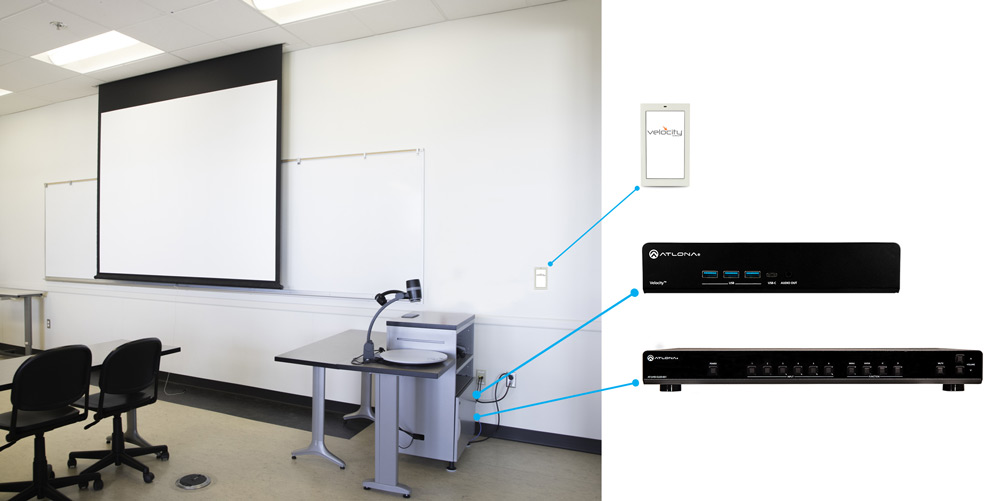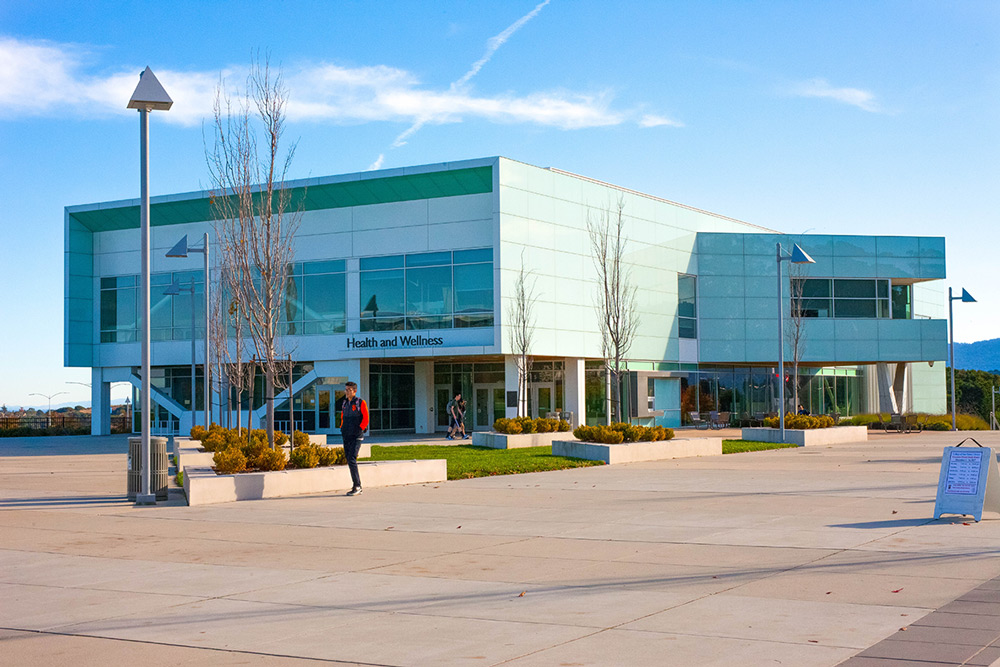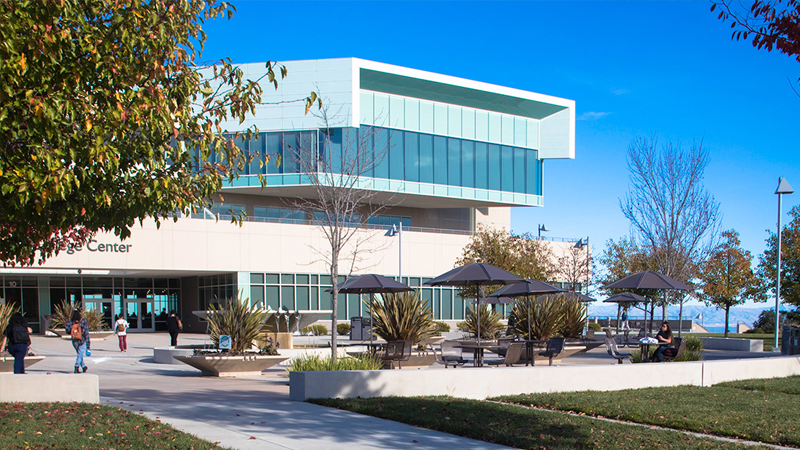
Case Study: College of San Mateo
The Value of Networked AV Control in Higher Education
A Community College in California takes a big leap forward with Atlona’s Velocity, enjoying early operational dividends with a strong foundation for growth
As one of three higher education institutions that comprise the San Mateo County Community College District, the College of San Mateo offers a wealth of programs on its 153-acre campus across traditional, semester-length, and short courses.
Nursing represents one of its more popular traditional programs. And inside its two main nursing laboratories, the College of San Mateo’s IT support technician is charting new territory on how AV technology is being applied for systems control on a higher ed campus.
Inside the nursing labs, students and instructors rely on the usual mix of classroom technology to support learning and curriculum – document cameras, Blu-ray players and TV displays with HDMI and VGA connections. More recently, Apple TVs have been added to the mix to simplify content management and streaming.
For the past six years, this modest mix of mostly consumer-grade equipment has been managed over a legacy AV control system. That system also is used across a majority of the traditional classrooms around campus.
However, as more technologies move to the network, IT Support Technician Alexis Arreola – and the instructors and venues he works with – have increasingly found themselves limited by scope and functionality, and concerned about scalability challenges. The latter proved especially concerning based on the college’s plans to erect a new building with classrooms, conference rooms and huddle rooms; and a desire to integrate more modern AV technologies in other classrooms around campus. It’s a journey that took them through evaluations of AV control system options on the market, and one that ultimately led them to Atlona.

Needs Assessment
As Arreola explains it, the nursing lab is an ideal for proving ground for technical upgrades. These are slightly larger spaces that are, generally speaking, using technology for the same applications as general classrooms: the display of live and recorded video to support learning and presentations.
The previous control system in the nursing lab was easy to use, but fairly inflexible. That limited options for use not only in classrooms, but also to support larger, live events in adjacent venues – increasingly a requested application on campus.
“Instructors want to do more today, and we really had a desire to give them more flexibility to access our Samsung UF 130dx document cameras and Apple TV devices over the network,” said Arreola. “At the same time, they were used to a fairly simple control setup. We needed a system with a true networked approach to control, without added complexity in operation. We didn’t want to install a system with an overabundance of buttons that would intimidate users, or require an extended learning curve.
“When it comes down to it, these are instructors that need to remain focused on education,” he added. “The last thing they need is to be concerned about an array of complicated buttons on the wall.”

Simplifying Control of Complex Spaces
Arreola quickly set his sights on Atlona’s Velocity system, which brought together the ease of use, scalability and networked architecture he was seeking. He was also quick to discover other benefits tied to quick configuration, analytics, and more forward-looking concerned such as redundancy.
Velocity is comprised of three distinct elements that work together as a single, unified platform. This includes Velocity Cloud, a centralized online resource for remote configuration, monitoring and service; Velocity Control Gateway, an IP-based processor with automatic failover capabilities that plays a key role in scalability; and Velocity Touch Panels, which are the 5.5- or 8-inch touchscreens that instructors and other users do or will interface with in classrooms, conference rooms and venues.
All three of these components have proven invaluable for Arreola at the starting gate. The ease of launching and using the system in the two nursing labs, along with the foundation now in place to scale to other buildings and rooms, has provided a sense of relief as the campus prepares to move into a new phase of AV technology adoption and use.
“The Velocity Cloud online resource was instrumental in accelerating phase of the deployment,” said Arreola. “Simply put, you’re following simple commands on an uncluttered GUI to add devices. Once the devices go live, it’s easy to monitor and troubleshoot performance. Things get more interesting for us with the control gateway. This is how we will grow our networked control architecture with relative simplicity.”
As Arreola explains it, the gateway accommodates communication between the sources and destinations on the network.
“We use this to remotely control devices and switch sources,” said Arreola. “Recently there was an instructor who was seeing the touch panel for the first time, and while the learning curve is not intense it was still completely unfamiliar. I was able to talk her through the process of using the touch panel without issue, and make the immediate changes she needed over the online gateway.”
Arreola chose the 5.5-inch Velocity Touch Panels for each space, Instructors and presenters use them mainly to turn projectors and cameras on and off, noting that each panel offers a user-friendly interface for navigation.
“There’s a real wow-factor now that was lacking before,” he said. “We’ve come from a legacy panel with six pushbuttons to a sleek panel that requires one touch of the interface to bring everything online. And from an integration point of view, we like how clean it is.We connect one Cat6 cable to the back, and it’s on the network. It’s very simple to install.”
However, for future needs the Velocity Control Gateway brings something of high importance: a scalable, networked architecture.While the current incarnation of the system relies on an IP-based server appliance to interface with up to 250 devices, Arreola expects to soon migrate to a cloud-based software license. That license is hosted on a central IT infrastructure, and will support up to 5,000 devices.
“That expandability is going to be what matters in the long run,” said Arreola. “We currently have 173 classrooms on campus, many of which fall under the definition of smart classrooms. Those classrooms include more commercial AV gear, including Epson G7000w projectors and Atlona AT-UHD-CLSO-612 presentation switchers. The new building being raised will add huddle rooms and conference rooms with similar gear. Velocity will allow us to support all of these spaces, connect to the district office, and eventually into the Skyline College and Canada college, which are our other two colleges in the system. So, it’s pretty clear we will quickly move beyond 250 networked devices to control, and Velocity is really our own gateway to a networked control architecture system-wide.”

Analyze Me
Migration to a networked control architecture has proven beneficial from a cost and labor perspective – as well as for phasing out aging technologies. To the latter point, Arreola has found the system analytics within Velocity especially useful.
“We’re really working to retire VGA connectivity, which is still very common in educational facilities,” said Arreola. “We really want to get wrap our heads around how many faculty members are still connecting through VGA. And likewise, how many classrooms are still showing video through DVD players and Blu-ray players, versus using more online videos for instruction and connecting through the USB ports on the laptops? Velocity provides metrics and analytics in the cloud that will help us make informed decisions on technology choices for classrooms.”
The phasing out of older technologies goes hand-in-hand with the slimmed down infrastructure of a networked control system.
“Our legacy control system requires a large number of cables running from point to point,” said Arreola. “We’re now able to add new sources and destinations without the cost and labor of legacy wiring. Since everything is connected to the network, we can add switchers, players and projectors to the platform without all that work, and even copy and paste configurations across rooms as new ones come online. “
As they transition to the more software-defined gateway in the future, Arreola expects to enact Velocity’s IP-based redundancy features to ensure that rooms remain online in the event the primary network is offline for any reason.
Conclusion
“We’re getting a lot of positive feedback early on, mainly from instructors who are only aware of the touch panels and might think that’s the entire system,” said Arreola. “What’s happening behind the scenes on the network across configuration, programming, scalability and remote control is what is really bringing the value. We see a lot of new opportunity moving forward, especially now that we have reduced the labor and operational challenges of AV control by moving these applications to the network.”
| PRODUCTS FEATURED | |
| Model | Description |
| Velocity Cloud | Online portal for AV integrators, facility AV/IT system administrators, and tech managers to remotely configure, monitor, and service Atlona Velocity Control Systems, from anywhere and anytime, with any device through a web browser |
| AT-VGW-250 | AV control processor for the Atlona Velocity Control System, capable of serving up to 250 simultaneous IP device connections for Atlona and third-party AV devices, Velocity touch panels, and BYOD control |
| AT-VTP-550 | 5.5” touch panel for the Atlona Velocity Control System |
| AT-UHD-CLSO-601 | An advanced six-input, multi-format switcher with built-in 4K scaling |
| AT-UHD-CLSO-612ED | An advanced six-input, multi-format switcher with built-in 4K scaling and mirrored HDMI/HDBaseT outputs |







